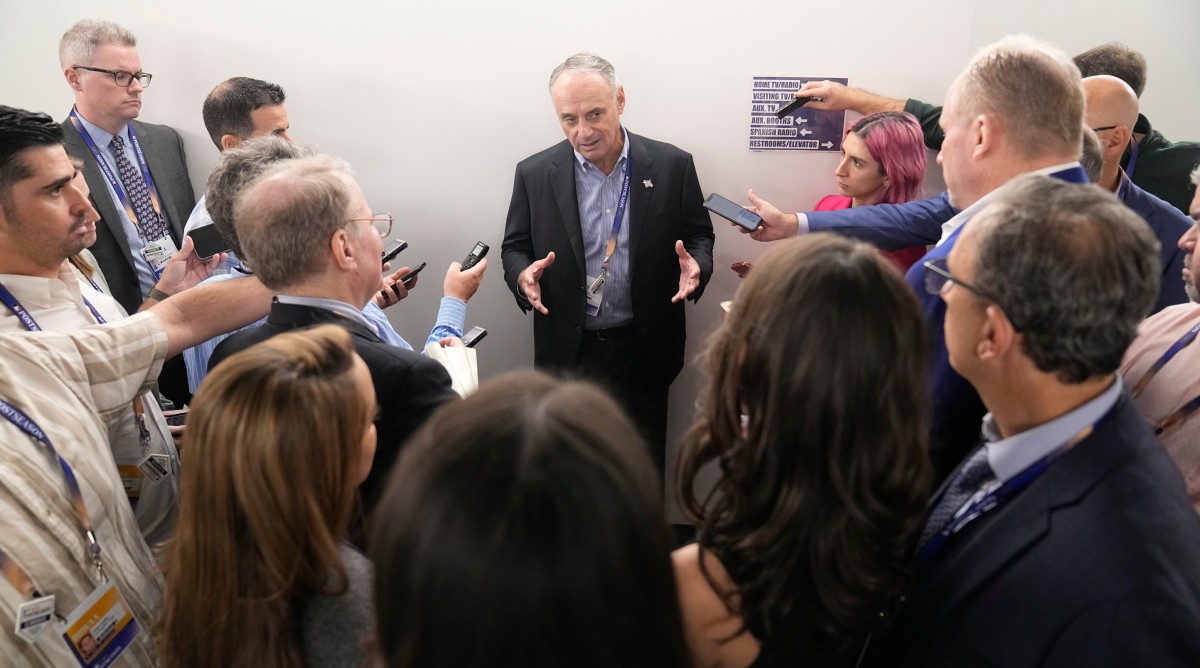MLB Planning to Broadcast Diamondbacks, Padres Games in 2024

ARLINGTON, Texas — Major League Baseball is prepared to spend another year broadcasting games for at least two teams—including the National League pennant-winning Diamondbacks—amid uncertainty about the regional sports network model, commissioner Rob Manfred said on Friday before Game 1 of the World Series.
Diamond Sports Group, a subsidiary of Sinclair that owns Bally Regional Sports Network and until recently held the rights to air the games of 14 MLB teams, went into Chapter 11 bankruptcy proceedings in March. In May, Diamond lost the rights to the Padres after failing to pay them their rights fees, and MLB took over broadcasts. It charged fans $19.99 per month—or $74.99 for the rest of the regular season—to watch games on MLB.com and also aired games on cable through additional channels. In July, MLB went through the same process with the Diamondbacks, whom Diamond had also failed to pay.
“We will be in a position that we can handle up to 16 teams next year,” Manfred said. He added that despite his unhappiness with the process, he believes that the league’s future is in streaming.

“I give you the San Diego example,” he said. “We had virtually no notice—I mean, literally hours’ worth of notice. We picked them up in the middle of a season, and, frankly, picked them up when things weren’t going like a lot of people, particularly in San Diego, had hoped. And we sold 18,000 subscriptions in San Diego. And our ratings on the cable side essentially stayed the same; they were a little better. So what does that tell me? We have an unserved audience out there that is an economic opportunity for us to reach fans that we’re not reaching. So it’s an important part of our future. It doesn’t have today the same robust economics that the cable bundle provided as an exclusive source of distribution, but my own view of the world is we’re gonna have—the distribution may be smaller going forward, and we’re gonna put with it that digital option that gives people more flexibility, more reach and [is] better for fans overall.”
In May, Manfred testified in bankruptcy court that the league was prepared to subsidize teams dropped by Diamond up to 80% of what they would have made in 2023 alone. He has said that the league will not subsidize them at all in ’24. He declined to speculate in detail what it might mean for payroll for those teams going forward if they are making no money from TV deals.
“Our No. 1 priority, and we’ve actually filed a motion in bankruptcy [court], is we need to know who they want to continue to broadcast and who they don’t want to continue to broadcast so that we can make plans in order to deliver games to our fans,” he said. “Until we have a feel for that, it’s very difficult to give the teams a realistic view of what the economics are going to be. One of the reasons Fox had all those RSNs is when you have a lot of them, usually your economics are better than if you have three or four. And I think that’s the important variable. Player spending—I think that clubs, certainly I do and I think clubs in general believe in the inherent value of the content, and when you believe in the inherent value of the content, it may not be tomorrow, but you’re gonna monetize that content effectively. And I think they will continue to make player decisions under the assumption that we will figure out a way to monetize the content.”
Sinclair bought the networks from Fox for $9.6 billion in 2019. The rise in streaming and decline in cable subscriptions has made those properties much less valuable; Diamond CEO David Preschlack testified in bankruptcy court in May that the Diamond streaming service has only about 200,000 subscribers, and the company has said it owes $8.67 billion.
